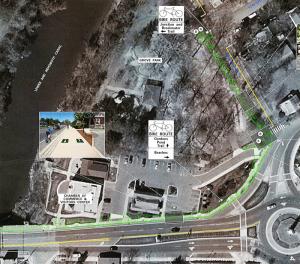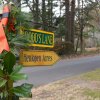DelDOT eyes 2018 construction start for Rehoboth trail extension
Construction on a pathway to link the Junction & Breakwater Trail and downtown Rehoboth Beach could begin in 2018, state transportation officials say.
Locals, however, are still not convinced the proposed route is the best way to get bicyclists and pedestrians into town or lead them into Rehoboth’s commercial areas.
Bicyclist and Rehoboth resident Jay Lagree told officials at a recent meeting, “It’s not going to be very safe. I think they are doing the best they can do, but it’s not a good thing.”
Bruce Kauffman, a bicyclist who lives just outside Rehoboth, said the proposed link will help casual riders but not people cycling to work in the central business area.
“They’re on the right track. I hope they get it done right. With the proper signage, they can talk to two different types of riders,” he said.
Commissioner Paul Kuhns, himself a cyclist, said, “My concerns are safety. My feeling is this is not safe. Right now, in the summertime, there are a lot of people that walk across the bridge.”
Kuhns said bicyclists traveling at a high rate of speed on the same pathway as beachgoers carrying chairs is not a good mix.
Kuhns said the city has little control over the trail outside the town, but city officials should take a more active role in planning the route once the trail crosses the Lewes-Rehoboth Canal bridge. He suggested a marked bike path through town that would lead people into city neighborhoods. Kuhns said Rehoboth Avenue is too dangerous for bicycles, but people could get off their bikes at the circle entrance to Rehoboth and walk into town. Delaware Department of Transportation officials plan to use the crosswalks at the circle to help pedestrians and cylists cross Rehoboth Avenue.
“They’re doing the best they can, but safety is the concern,” Kuhns said.
DelDOT has proposed extending the trail from Holland Glade Road to the light at Church Street. From there, the trail would turn onto Rehoboth Avenue Extended and cross the drawbridge to the traffic circle, where the trail would veer left to Henlopen Avenue. From Henlopen Avenue, users could then take the trail all the way to Cape Henlopen State Park.
DelDOT planner Jon Hermes said plans call for a 10-foot sidewalk on the westbound lane of the drawbridge. DelDOT would maintain the existing bike lanes on the bridge in both directions. The bridge currently has 6-to-8-foot sidewalks on both sides. DelDOT would reconfigure the travel lanes to get an additional two feet on the westbound lane. DelDOT proposes faster moving bikes could continue to use the bike lanes on the roadway, while those walking or riding slowly could use the sidewalk. To get around city regulations against riding on the sidewalk, DelDOT refers to the section of the sidewalk that bikes would use as part of the trail.
“The two-way traffic is going to go on the bridge with pedestrians. I think that’s crazy,” said Dennis Diehl, a member of the city’s Streets and Transportation Committee. Diehl said the proposed plan also offers no link into the central business area for bicyclists or pedestrians, including the many who would ride into Rehoboth from the trail.
Lagree said, “Putting bikes and people together is very difficult.”
Once across the bridge, the sidewalk in front of the Rehoboth Beach Museum and Rehoboth Beach-Dewey Beach Chamber of Commerce visitors center would be widened to 10 feet and used by cyclists and pedestrians. The plan calls for 10 feet of sidewalk to be installed adjacent to Grove Park, winding around to Henlopen Avenue.
“What we’re trying to do with this project is provide opportunities so people who want to be on road can still use the roadway, and people who don’t feel comfortable will have a separate path, so casual riders and walkers will have a dedicated area to go to,” Hermes said.
He said a secondary goal of the project, which has no cost estimates at this time, is to provide direction for people coming from the trail to get into and around Rehoboth. Hermes said as time goes on, people will get used to how the trail connection works.
“This is not to be a high-speed area. It’s to provide extra room for safety and guidance. You can still use the road, so anyone who wants to ride their bike on the road will still have that opportunity,” he said.
Hermes said there are a great deal of limitations DelDOT had to work within to create the plan, such as private property along the route, street parking and the size of the bridge.
“It was tricky,” he said.
One issue on the minds of residents was the idea of a separate bicycle and pedestrian bridge over the Lewes-Rehoboth Canal. While DelDOT owns the road, the canal and its banks are under the control of the U.S. Army Corps of Engineers.
“We need to take the canal back from the Corps of Engineers, but I think that’s a real political forum. If the city had the canal, we could build a nice bridge,” Lagree said.
If the city had access to the canal, it could also landscape the area as called for in the city’s comprehensive development plan, he said.
Hermes said a separate bridge is not feasible because there is no space for on-and-off approaches, noting condos on one side and the museum and Grove Park on the other. Hermes said because the canal is a navigable waterway, state regulations require the bridge to be at least as high as the canal bridge on Route 1.
“It would be a great idea to have a separate bridge,” Hermes said.
“But it’s not in the foreseeable future. The bridge would have to meet requirements such as height. To get up to that height would make it almost impossible to get back down. It’s built up on either side. There’s no plans for that,” Hermes said.
Ryan Mavity covers Milton and the court system. He is married to Rachel Swick Mavity and has two kids, Alex and Jane. Ryan started with the Cape Gazette all the way back in February 2007, previously covering the City of Rehoboth Beach. A native of Easton, Md. and graduate of Towson University, Ryan enjoys watching the Baltimore Ravens, Washington Capitals and Baltimore Orioles in his spare time.

























































